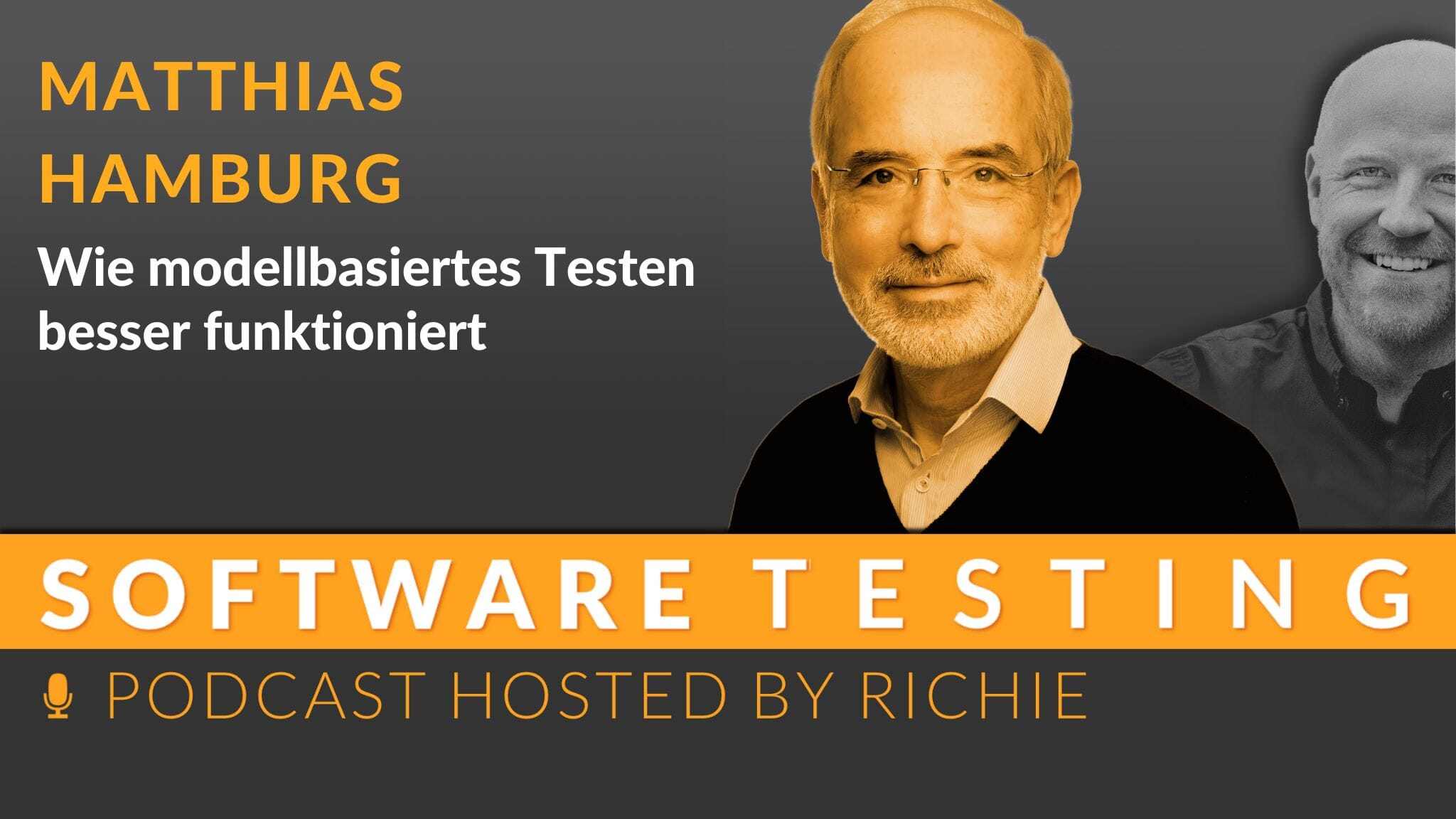Testing Enterprise Software
The challenges and methods of testing in large enterprise environments are of central importance, especially in the context of SAP and other...

In this episode, I talk to Matthias Hamburg about model-based testing. Matthias is an experienced expert in the software testing community and provides valuable insights into the problems and solutions of model-based testing. He reports on studies that show that test automation often does not deliver the desired results and explains the difficulties he has experienced in practice, such as insufficient modeling knowledge and gaps between modeling and test execution. Matthias introduces a new tool designed to close these gaps and emphasizes the importance of no-code generation to make testing easier. A fascinating conversation about the future of software testing!
"The World Quality Report shows that test automation often fails to achieve the business goals that were hoped for." - Matthias Hamburg
Matthias Hamburg was Managing Consultant at Sogeti Deutschland GmbH until his retirement in 2019. His professional focus is on test analysis, test management and test process improvement. He continues to volunteer for the German Testing Board (GTB) and its umbrella organization ISTQB. Among other things, he publishes the Advanced Test Analyst syllabus and the standard glossary of testing terms in English and German.
Model-based testing (MBT) promises efficiency and quality assurance at the highest level. In practice, however, MBT often fails to deliver the expected results. Studies such as the World Quality Report by Capgemini and Sogeti confirm this phenomenon: test automation often fails to achieve business objectives. CI/CD processes stutter instead of running smoothly, and the expected increase in efficiency does not materialize. There seems to be a gap between the brilliant theory and the sobering practice.
One of the main problems with model-based testing is the lack of professional training in modeling techniques. Imagine someone trying to play a complex piece of music without any knowledge of sheet music - the result will hardly be convincing. Similarly, a lack of training for testers leads to inefficient models. In addition, there is often no seamless transition from modeling to test execution. Gaps open up between test design and implementation, making the process more difficult. Tools such as Selenium or Playwright are helpful instruments, but they do not completely close these gaps.
But there is hope on the horizon. A new tool is entering the scene and addressing precisely these challenges. It initially generates abstract test cases from the model that can be checked manually - a kind of dress rehearsal before the curtain falls. As soon as a concrete application is available, the abstract test cases are executed automatically. This seamless transition from modeling to test execution is like a well-oiled gear in the gears of quality assurance. It is particularly noteworthy that the tool also reacts flexibly to changes in the software and adapts accordingly.
This tool has already demonstrated its strengths in a pilot application. It made it possible to try out new methods and optimize the entire test process. The two-phase approach - first generating abstract test cases and checking them manually, then automating them - has proven to be particularly effective. It not only helps to identify early errors, but also improves overall quality assurance. A win-win situation, you could say.
Of course, this new tool is not the end of the line. There is still room for improvement. Support for data-driven testing could be expanded and additional test design methods such as equivalence class formation could be integrated. But the direction is right. If such tools are used more widely in the future, systematic test procedures could finally be given the status they deserve.
Model-based testing is an approach in which tests are created on the basis of formal models of the system under test. These models represent the expected behavior and are used to automatically generate test cases.
Model-based testing enables efficient test case generation, improves test coverage and reduces manual effort. It helps to detect errors at an early stage and increase the quality of the system.
In contrast to traditional methods based on manual test case creation, model-based testing uses formal models to automatically generate test cases. This leads to more systematic and comprehensive test coverage.
Various models such as state machines, sequence diagrams, activity diagrams or decision tables are used. The choice of model depends on the specific requirements and the system to be tested.
By introducing modeling tools and training the test team, model-based testing can be gradually integrated into existing processes. It is important to analyze existing test cases and create models accordingly.
There are various tools such as Tosca MBT, Conformiq or IBM Rational Test Workbench that support modeling and automatic test case generation.
Challenges can include the initial effort required to create the model, the complexity of the models and the need for expert knowledge within the team.
By systematically modeling all possible system states and transitions, tests can be generated that ensure comprehensive coverage and thus reduce the risk of undetected errors.
Yes, model-based testing can be used in agile environments. It supports rapid iterations and adaptations, as models can be easily updated and new test cases can be generated automatically.
Model-based testing enables the automatic generation of test scripts from models, which increases the degree of automation and reduces the effort required for manual test case creation.
Model-based testing improves the efficiency of test automation by creating clear, visual models of software requirements. These models enable structured test case generation, avoiding redundant tests and increasing test coverage. In addition, changes in the software design can be quickly integrated into the test models, which simplifies the adaptation of test automation. This makes the test process faster, more cost-efficient and more precise, as errors are detected at an early stage.
Yes, model-based testing is a suitable method for agile software development. It enables rapid adaptation to changing requirements, as tests can be derived directly from models. The visual representation of functions and processes facilitates communication within the team and promotes understanding of the system. In addition, model-based testing supports the automation of test cases, which increases efficiency and test coverage. It therefore fits in well with the dynamic and iterative nature of agile projects.
Model-based testing increases test coverage by systematically capturing all possible inputs and states of a system in a model. This allows test cases to be generated automatically that cover all relevant functions and exceptions. This reduces the risk of overlooking important scenarios. By using graphical models, it is easier to visualize complex processes and identify gaps in test coverage. Overall, model-based testing leads to a more comprehensive and targeted testing strategy that improves software quality.
Model-based testing can be hindered by unclear models that are difficult to understand and insufficient coverage of test cases. In addition, adapting models to changes in the software can be time-consuming. The team often lacks the necessary expertise to create and use models effectively. Finally, technical difficulties, such as integration into existing test environments, can present additional challenges. These factors have a negative impact on the efficiency and quality of the test process.
Various tools are suitable for model-based testing, including
This software helps to automatically derive test cases from models and increase efficiency in the testing process.
In order to successfully integrate model-based testing into existing test processes, clear test objectives should first be defined. It is then important to create a suitable model that maps the software requirements. These models must then be translated into test cases. Training for the team is essential to ensure that everyone understands the new methods. Finally, suitable tools to support model-based testing should be selected and implemented. Continuous feedback helps to continuously improve and adapt the process.
State models, activity diagrams and decision models are often used in model-based testing. These models make it possible to clearly represent and understand the system behavior. The advantages lie in automated test generation, early error detection and improved test coverage. This makes the test process more efficient and effective, as relevant test cases can be created in a targeted manner.
The main difference between model-based testing and traditional testing methods lies in the approach. Model-based testing uses formal models to automatically generate test cases, which enables more comprehensive test coverage. Traditional methods, on the other hand, are often based on manual scripts and the experience of testers, which can lead to gaps and repetition. In addition, model-based testing is more flexible and quicker to adapt to changes in the system, while traditional methods are usually more time-consuming.
The most important advantage of model-based testing is the automated generation of test cases from models, which reduces time and effort. It also improves test coverage as it precisely maps system behavior. Model-based testing enables early error detection and promotes collaboration between developers and testers by creating a common basis. This increases the quality of the software and makes risks more transparent. Ultimately, this leads to more efficient and targeted test processes.
Model-based testing is a test methodology in which models of the system to be tested are created in order to automatically generate test cases. These models represent the behavior and requirements of the system. The advantages of model-based testing include higher test coverage, faster test case generation and early error detection. It also enables efficient reusability of test cases and reduces the manual effort involved in test execution.

The challenges and methods of testing in large enterprise environments are of central importance, especially in the context of SAP and other...

Podcast Episode: Contract-Based Testing Mariusz is an expert in contract-based testing. In this interview, we talk about what CBT is all about, how...

Podcast Episode: Test Pyramid - A Critical Look Everyone knows the test pyramid, everyone immediately has its image in mind. Sometimes it has three...